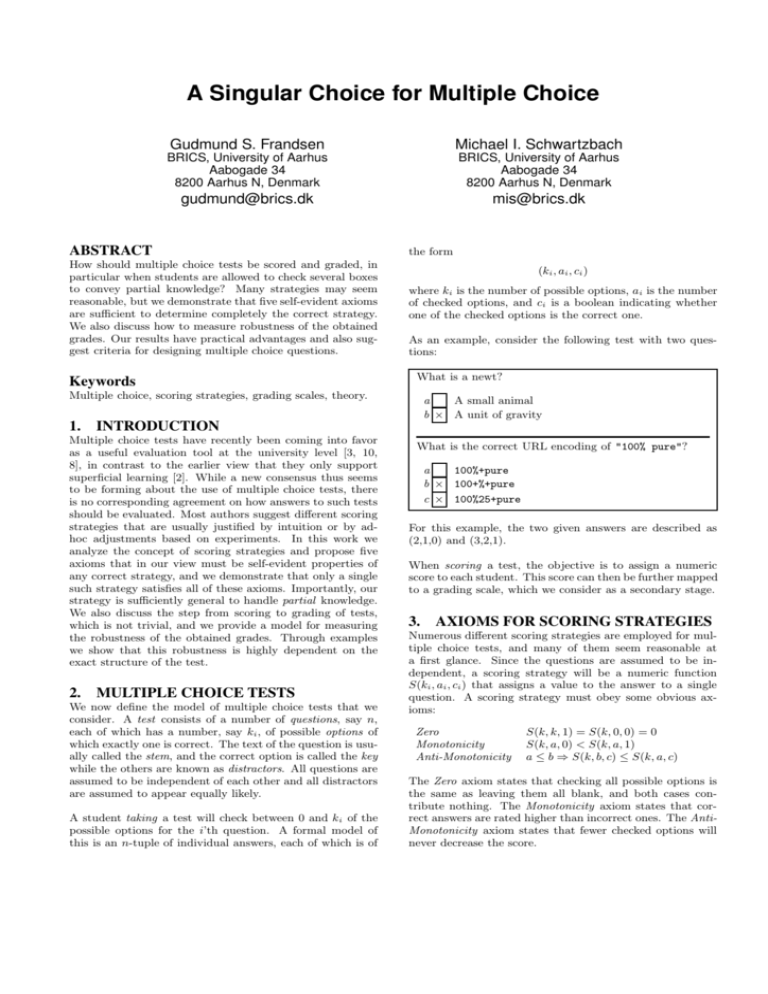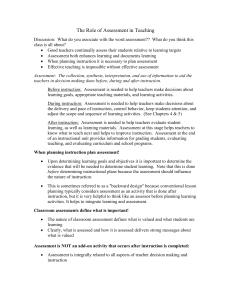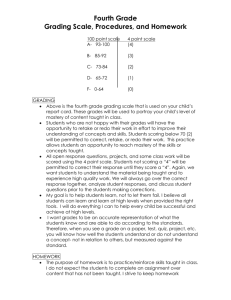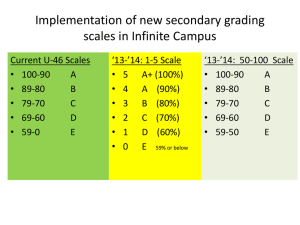A Singular Choice for Multiple Choice
advertisement

A Singular Choice for Multiple Choice
Gudmund S. Frandsen
Michael I. Schwartzbach
gudmund@brics.dk
mis@brics.dk
BRICS, University of Aarhus
Aabogade 34
8200 Aarhus N, Denmark
ABSTRACT
How should multiple choice tests be scored and graded, in
particular when students are allowed to check several boxes
to convey partial knowledge? Many strategies may seem
reasonable, but we demonstrate that five self-evident axioms
are sufficient to determine completely the correct strategy.
We also discuss how to measure robustness of the obtained
grades. Our results have practical advantages and also suggest criteria for designing multiple choice questions.
Keywords
Multiple choice, scoring strategies, grading scales, theory.
1.
INTRODUCTION
Multiple choice tests have recently been coming into favor
as a useful evaluation tool at the university level [3, 10,
8], in contrast to the earlier view that they only support
superficial learning [2]. While a new consensus thus seems
to be forming about the use of multiple choice tests, there
is no corresponding agreement on how answers to such tests
should be evaluated. Most authors suggest different scoring
strategies that are usually justified by intuition or by adhoc adjustments based on experiments. In this work we
analyze the concept of scoring strategies and propose five
axioms that in our view must be self-evident properties of
any correct strategy, and we demonstrate that only a single
such strategy satisfies all of these axioms. Importantly, our
strategy is sufficiently general to handle partial knowledge.
We also discuss the step from scoring to grading of tests,
which is not trivial, and we provide a model for measuring
the robustness of the obtained grades. Through examples
we show that this robustness is highly dependent on the
exact structure of the test.
2.
MULTIPLE CHOICE TESTS
We now define the model of multiple choice tests that we
consider. A test consists of a number of questions, say n,
each of which has a number, say ki , of possible options of
which exactly one is correct. The text of the question is usually called the stem, and the correct option is called the key
while the others are known as distractors. All questions are
assumed to be independent of each other and all distractors
are assumed to appear equally likely.
A student taking a test will check between 0 and ki of the
possible options for the i’th question. A formal model of
this is an n-tuple of individual answers, each of which is of
BRICS, University of Aarhus
Aabogade 34
8200 Aarhus N, Denmark
the form
(ki , ai , ci )
where ki is the number of possible options, ai is the number
of checked options, and ci is a boolean indicating whether
one of the checked options is the correct one.
As an example, consider the following test with two questions:
What is a newt?
a
A small animal
b × A unit of gravity
What is the correct URL encoding of "100% pure"?
100%+pure
a
b × 100+%+pure
c × 100%25+pure
For this example, the two given answers are described as
(2,1,0) and (3,2,1).
When scoring a test, the objective is to assign a numeric
score to each student. This score can then be further mapped
to a grading scale, which we consider as a secondary stage.
3. AXIOMS FOR SCORING STRATEGIES
Numerous different scoring strategies are employed for multiple choice tests, and many of them seem reasonable at
a first glance. Since the questions are assumed to be independent, a scoring strategy will be a numeric function
S(ki , ai , ci ) that assigns a value to the answer to a single
question. A scoring strategy must obey some obvious axioms:
Zero
Monotonicity
Anti-Monotonicity
S(k, k, 1) = S(k, 0, 0) = 0
S(k, a, 0) < S(k, a, 1)
a ≤ b ⇒ S(k, b, c) ≤ S(k, a, c)
The Zero axiom states that checking all possible options is
the same as leaving them all blank, and both cases contribute nothing. The Monotonicity axiom states that correct answers are rated higher than incorrect ones. The AntiMonotonicity axiom states that fewer checked options will
never decrease the score.
Thus, for any scoring strategy, the lowest possible score is
X
S(ki , ki − 1, 0)
try to argue subjectively for a particular strategy, we will introduce two further axioms that we believe to be self-evident
and that will completely define a single scoring strategy.
which corresponds to checking all options except the correct
one, and the highest possible score is:
X
S(ki , 1, 1)
The first axiom observes that the evaluation of a multiple
choice test should be invariant under a simple transformation. Consider the example test shown in Section 2. We
could choose to combine the two questions into a single one,
and the student would correspondingly combine his answers:
i
i
which corresponds to checking only the single correct option.
4.
A MULTITUDE OF STRATEGIES
The above three axioms are not enough to completely determine a scoring strategy. Ideally, a scoring strategy should
correctly measure the knowledge of the student, but students may of course attempt to guess answers rather than
admit ignorance. Thus, the interplay between the scoring
strategy and the student’s strategy must be considered.
The simplest possible scoring strategy is:
1 if a = c = 1
Sabsolute (k, a, c) =
0 otherwise
Here, only single correct options are given credit. This strategy has several problems: partial knowledge is not credited,
and since there is no penalty for guessing, students will never
leave questions unanswered.
Guessing can be discouraged by assigning a negative score
to incorrect answers. A simple example strategy could be:
8
< 1 if a = c = 1
−1 if c = 0 ∧ a = 1
Sharsh (k, a, c) =
: 0 otherwise
As indicated, this is a rather harsh strategy. A student that
knows 70% of the answers and falsely believes that he knows
the remaining 30% would score only 40%. This highlights
a need to distinguish between guessing and giving wrong
answers in good faith.
A more lenient strategy, which is
8
1
<
1
− k−1
SRoberts (k, a, c) =
:
0
proposed in [8], is:
if a = c = 1
if c = 0 ∧ a = 1
otherwise
Here, the penalty for an incorrect answer is scaled by the
number of distractors.
Partial knowledge may be credited in many different ways.
A simple scoring strategy could in this case be:
1/a if c = 1 ∧ 0 < a < k
Spartial (k, a, c) =
0
otherwise
The idea of giving proportionally reduced credit for multiple
options is appealing, but is not the logically correct choice,
as we show in the next section.
5.
TWO DEFINING AXIOMS
It is easy to check that the above proposed scoring strategies
all satisfy the three basic axioms, and that infinitely many
other strategies may seem equally reasonable. Rather than
What is a newt and what is the correct URL encoding
of "100% pure"?
a
A
b
A
c
A
d
A
e × A
f × A
small animal and 100%+pure
small animal and 100+%+pure
small animal and 100%25+pure
unit of gravity and 100%+pure
unit of gravity and 100+%+pure
unit of gravity and 100%25+pure
Clearly, the same amount of knowledge has been displayed
by the student, thus the contribution to the numeric score
should be unchanged. We can phrase this as an Invariance
axiom:
S(k1 , a1 , 1) + S(k2 , a2 , 1) = S(k1 k2 , a1 a2 , 1)
This has the unique solution
k
S(k, a, 1) = log( )
a
In retrospect, this is clearly the correct strategy, since it
measures the number of bits of information that the student
has contributed.
We still need to determine the numeric score of an incorrect
answer. From an information theoretic point of view the
value should be −∞, but that is clearly not what we want.
Recall that guessing should be punished but wrong answers
given in good faith should not. There is only one balance
point between these two points of view, namely that the
expected outcome from guessing should be zero. This can
be expressed by the following Zero-Sum axiom:
`k−1´
` ´
S(k, a, 1) + k−1
S(k, a, 0)
a−1
=0
`k ´ a
a
For wrong answers where a 6= k and a > 0, we again obtain
a unique solution
a
k
log( )
k−a
a
So, wrong answers receive a negative score, but a more modest one than in the harsh strategy.
S(k, a, 0) = −
6. THE CORRECT SCORING STRATEGY
Combining the five axioms we have proposed,
a uniquely determined scoring strategy:
8
0 if a = 0
<
log( ak ) if a > 0
Saxioms (k, a, c) =
:
a
− k−a
log( ak ) if a > 0
we arrive at
∨ a=k
∧ c=1
∧ c=0
To the best of our knowledge, this strategy has not been
proposed before. Note that any other strategy is bound to
violate one of our five axioms, and reasons for doing so seem
difficult to justify.
An interesting special case is a test consisting of only yes/no
questions. In this situation, our scoring strategy specializes
to the following:
8
0 if not answered
<
log(2) if correct
Sbinary (k, a, c) =
:
− log(2) if incorrect
which is in this case the same as Sharsh , since a scoring strategy may of course be scaled with an arbitrary factor. The
binary strategy simply states that correct and wrong answers must be inverses of each other and a question not
answered should yield zero The fact that wrong knowledge
is worse than no knowledge was of course already observed
by Socrates who stated “I know nothing except the fact of
my ignorance”. It seems to be a folklore result that binary
multiple choice tests should be graded in this manner.
7.
FROM SCORING TO GRADING
The scoring strategy assigns a numeric score to a test, but
usually this must be transformed into a grade on some fixed
scale. The discrete nature of grade scales introduces some
additional complications.
For example, who should receive the lowest grade? Clearly, a
score of zero must be rewarded with the lowest grade, since
no knowledge has been demonstrated. As a consequence,
all negative scores must similarly receive this grade. This
means that if a student is certain that his true knowledge
results in a score of zero or less, then guessing clearly pays
off. In reality, this will be a rare case, but the same situation
happens at all other grades. If a student is absolutely certain
that his true knowledge places him just below a B grade,
then it pays off to perform a limited amount of guessing, as
long as the maximum negative score he risks is small enough
that he cannot slip below a C grade. These considerations
simply indicate that grading scales ideally should have small
intervals.
On the ECTS grading scale, however, the distinction between the grades FX and F could suggest that negative
scores could be mapped to the grade F while zero scores
would yield the grade FX. On the US grading scale, there is
no distinction between these two grade levels.
the questions determine the average and distribution of the
scores.
8. ROBUSTNESS AND CONFIDENCE
A multiple choice test is prepared, the students take the
test, and the answers are subsequently scored and graded.
An interesting question is to consider how robust the resulting grades are when random guessing by the students is
considered.
Intuitively, more questions and more options make the test
more reliable, but how many questions and options are necessary to give a robust test? Relying on intuition only is
problematic. If your test is under-robust you cannot trust
the result to the extent you believe, and if it is over-robust
you could have saved precious time by generating fewer questions and distractors.
We propose a formal definition of robustness that makes it
possible to check in advance whether a multiple choice test
[k1 , k2 , . . . , kn ] (only the numbers of questions and options
are relevant) is robust with respect to an absolute grading
scale [t1 , t2 , . . . , tg ]. To motivate our definition let us consider some examples.
A student that knows nothing can by a lucky strike get a
full 100% score. Clearly, this is unavoidable. Similarly, if a
student has a score in the interval [ti−1 ..ti [ and very close to
ti , then he may increase the grade with probability 1 − k1 by
a single guess (with no risk at all if the test has reasonably
many questions). This situation is also unavoidable. The
two examples show that with sufficiently small probability
anything can happen, and a small deviation in the resulting
grade may happen with relatively large probability. But we
can demand that a robust test has large deviations only with
small probability, where large means more than one grade
off, and small probability is customarily taken to mean 5%
or less.
To obtain a percentage grade, the correct algorithm for our
scoring strategy is:
P
max(0, i S(ki , ai , ci ))
P
i log(ki )
Formally, we define the nonconfidence of a test with respect to a grading scale nonc([k1 , k2 , . . . , kn ], [t1 , t2 , . . . , tg ])
to be the maximum probability over i ∈ {1, . . . , g −1} that
a student whose true knowledge corresponds to a score in
the interval [ti−1 ..ti [ gets a score of ti+1 or more by guessing, i.e. that he advances two grades or more. The test
[k1 , k2 , . . . , kn ] is called robust with respect to an absolute
grading scale [t1 , t2 , . . . , tg ], if nonc([k¯i ], [t¯i ]) ≤ 5%.
Formally, we define a grading scale as an increasing vector of numbers in the interval ]0..1[, such as the commonly
used Danish scale [0.40, 0.50, 0.58, 0.66, 0.74, 0.82, 0.90]. In
absolute grading, these numbers are percentages that delimit the different grades, whereas in relative grading they
are percentiles. Note that for absolute grading the scheme
must depend on the individual test, since the difficulties of
To illustrate these definitions, consider a simplified version
of the Danish grading system, namely [0.40, 0.50], where a
student passes with a score of 50% or more and has a low
fail with a score of less than 40%. A test is robust for this
grading system if a student who deserves a low fail has probability of at most 5% of passing. What restrictions must a
robust test satisfy? We have computed lower bounds on the
number of questions needed to obtain a robust test when all
questions have k options:
Following this conversion, there are usually standardized
means of translating from percentage grades to other grading scales.
k
2
3
4
5
6
n
155
80
55
40
25
Note that the numbers in the table are lower bounds but
not necessarily optimal. For example, the entry n = 80 for
k = 3 means that any test with fewer than 80 questions that
each have 3 options is not robust, but we give no guarantee
that a test with 80 questions or more is robust.
Let us make a technical comment on why we cannot give
such a guarantee. Most importantly, the non-confidence
function is not monotonely decreasing as a function of n.
This may appear strange, but is due to the discrete jumps
between possible scores. Consider a test where all questions
have 2 options. If n = 15 then a low fail (<40%) can be at
most 33.4% and a pass (≥50%) is at least 53.3%. Adding
one question actually makes it easier for the student to guess
a passing score. If n = 16 then a low fail (<40%) can be up
to 37.5% and a pass (≥50%) can be as a little as 50%.
For k > 2, nontrivial scores may arise from the student selecting more than one option for some questions. This makes
it much harder to compute the non-confidence function. We
have chosen to compute a lower bound on the non-confidence
function rather than the exact function by restricting the
student to select a single option for each question. For this
reason, the numbers in the above table are only lower bounds
on the minimal n that leads to a robust test. These numbers
may appear surprisingly large, but the above grading system can hardly be considered unreasonably fine grained. It
is suggested in [10] that k = 3 is always an adequate choice,
but our numbers seem to suggest otherwise.
We do not consider the problem of guessing leading to lower
grades, since students may completely eliminate this risk by
refraining from guessing.
When using an absolute grading scale, we can assert robustness of a test without knowing anything about the students
who are going to take the test. When using a relative grading scale things are different. If all students have approximately identical true scores then even a little guessing may
lead to scores that rank them in essentially random order,
implying grades that are uncorrelated to their knowledge.
This may happen no matter how large and well designed
the test is, when student proficiency is not known in advance. Relative grading has another drawback. If there are
failing grades, it seems unreasonable to have a fixed percentile fail. This view is reflected in the ECTS scale that
has an absolute threshold for pass/fail and FX/F combined
with a relative distribution of the pass grades A,B,C,D,E. In
conclusion, without knowing the actual student scores, one
may estimate robustness of a multiple choice test only with
respect to absolute (parts of) grading scales.
9.
RELATED WORK
The literature on multiple choice tests falls in several categories. Many papers analyze the multiple choice paradigm
and provide criteria and tools for designing tests that are
valid for higher education [7, 9, 8, 10, 6, 4]. Additionally, much work in psychology and education deal with techniques for designing and phrasing stems, keys, and distractors. This is not really related to our work, so we do not provide references for this area. There is ample documentation
that well-designed multiple choice tests correlate with descriptive examinations, some recent example of which are [6,
3].
Two references are particularly relevant to our work. The
paper [4] discusses myths and misapprehensions about multiple choice tests. We note that the use of negative scores
and the distinction between guessing and “good faith” ignorance figures prominently in the discussions. The paper [5]
surveys scoring strategies for multiple choice tests that reward partial knowledge. Three different strategies are presented here. The strategy:
k−a
if c = 1
k
Sscale (k, a, c) =
0 otherwise
violates the Invariance and Zero-Sum axioms; the strategy
(originally from [1]):
8
1 if a = c = 1
>
>
<
0.5 if c = 1 ∧ a = 2
SAkeroyd (k, a, c) =
0.25 if c = 0 ∧ a = 0
>
>
:
0 otherwise
violates the Zero, Monotonicity, Invariance and Zero-Sum
axioms; and the strategy:
k−a
if c = 1
k−1
SBush (k, a, c) =
−a
otherwise
k−1
violates the Invariance and Zero-Sum axioms. While strictly
incorrect, the intuitions behind these grading strategies seem
to circle around ideas that are similar to our axioms: penalties for incorrect answers and scaling with the number of
distractors.
The previously mentioned strategy:
8
1 if a = c = 1
<
1
− k−1
if c = 0 ∧ a = 1
SRoberts (k, a, c) =
:
0 otherwise
does in fact coincide with our strategy (after suitable scaling
with a factor of log(k)) for the special case where partial
knowledge is not allowed and all questions have the same
number of options. Thus, our more general strategy may
be seen as a pathway for lifting some limitations inherent in
the underlying design of multiple choice tests.
Regarding the concept of robustness, we are not aware of
any related work. The papers [6, 8] examine the correlation
between grades obtained by multiple choice test and by descriptive examinations, but the innate robustness of a single
test is not quantified.
10. CONCLUSION
We have presented five axioms for multiple choice scoring
strategies that we believe to be self-evident. They uniquely
determine a novel scoring strategy that also deals with partial knowledge and questions with varying numbers of options. Our contribution seems to provide a logical answer to
a question that previous authors have either struggled with
or explicitly avoided.
The Web site http://www.brics.dk/Multiple contains an
online service for generating, scoring, and evaluating multiple choice tests using the results presented in this paper.
11. REFERENCES
[1] F. Akeroyd. Progress in multiple-choice scoring
methods. In Journal of Further and Higher Education,
6. Carfax Publishing, 1982.
[2] J. Biggs. Teaching for Quality Learning at University.
Open University Press, 1999.
[3] R. W. Brown. Multiple-choice versus descriptive
examinations. In 31st ASEE/IEEE Frontiers in
Education. IEEE, 2001.
[4] R. F. Burton. Multiple-choice and true/false tests:
myths and misapprenhensions. In Assessment and
Evaluation in Higher Education, 30(1). Carfax
Publishing, 2005.
[5] M. Bush. A multiple choice test that rewards partial
knowledge. In Journal of Further and Higher
Education, 25(2). Carfax Publishing, 2001.
[6] D. W. Farthing and D. McPhee. Multiple choice for
honours-level students? a statistical evaluation. In
Third Annual CAA Conference. CAA Centre, 1999.
[7] R. Lister. Objectives and objective assessment in cs1.
In SIGCSE 2001. ACM, 2001.
[8] T. S. Roberts. The use of multiple choice tests for
formative and summative assessment. In ACE 2006.
Australian Computer Society, 2006.
[9] D. Traynor and J. P. Gibson. Synthesis and analysis of
automatic assessment methods in cs1 – generating
intelligent mcqs. In SIGCSE 2005. ACM, 2005.
[10] K. Woodford and P. Bancroft. Multiple choice
questions not considered harmful. In ACE 2005.
Australian Computer Society, 2005.









